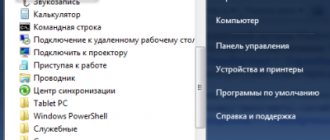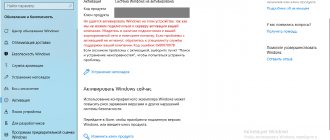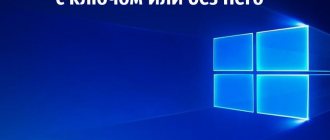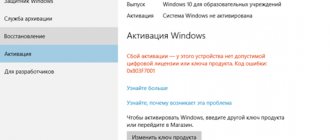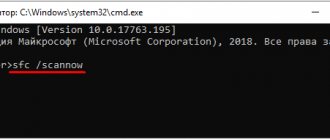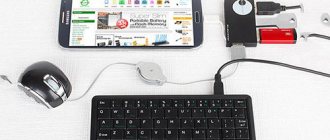Today we will figure out what will happen if you don’t activate
Windows 10. What restrictions we face due to this in different versions of the operating system and how to get around them. How long can you use an unactivated version of Windows 10 and is it necessary to activate it at all?
If you do not activate Windows 10 , a transparent message will appear on the screen prompting you to activate the system. Also, personalization options will be unavailable in the OS settings: changing wallpaper, color options. There are no other restrictions affecting performance.
Starting with Windows 10, Microsoft began to be very loyal to the activation and licensing of its operating system. It made it possible for everyone who needed to activate Windows 10 for free when it became available. You can also use keys from Win 7 and 8.
The most important thing is that it is no longer necessary to enter a 25-digit product license key when installing the official version downloaded from the Microsoft website. You can download a legal Windows 10 distribution from the Microsoft website onto your computer or laptop without any problems.
How to do this, see the article.
Then create a bootable USB flash drive with it and install your operating system.
What happens if you don’t activate Windows 10, as well as activation methods
For decades now, the minds of an entire generation have been concerned with the issue of activating Windows. Since the first year of the existence of the commercial version of the Windows operating system, resourceful programmers have come up with all sorts of ways to circumvent the mandatory purchase of a license. Many people did it quite well. But all this was a long time ago. How are things going with activating the new Windows 10 operating system? Let's look at this issue. Windows 10: an attraction of unprecedented generosity
The incredible happened. Microsoft has begun distributing “ten” on ISO images. Most likely, the company's marketers finally realized that this would be best. There is absolutely no point in releasing an operating system on disks. Pirates still expropriate everything. Therefore, now the question of choosing a method for activating the Windows 10 operating system requires some clarification. The problem is that today you just need to pay online to use the system, and consider that you have a licensed version of the OS. Lovely, isn't it? This attraction of unprecedented generosity can be explained by the fact that the company decided to rip off more money from users, using a subscription policy for this purpose. If previously it was enough to pay for a product once and use it until the end of time, today such a trick will no longer work. You will have to renew your subscription regularly, paying the same amount each time. Agree, not a bad strategy. In addition, the operating system is distributed completely free of charge. However, using it is no longer free at all. The company decided to switch to a subscription principle. This means that the user can only pay for a year of using the operating system with a one-time payment. If you want more, then please pay more. As you can guess, this policy irritates many personal computer owners. Therefore, it is not at all surprising that many of them began to wonder: what will happen if you do not activate Windows 10? Let's look at this point.
Windows 10: what happens if you don't activate it
It’s worth saying right away that there is nothing wrong with an unactivated Windows 10. Long gone are the days when Windows frightened users with a black desktop and reminders to activate the operating system. Now everything is completely different. There is a watermark in the lower right corner of the screen that notifies the user that the system has failed activation. That's all. Nothing more. Agree, it's scary. If that's all, then why should you pay extra to activate Windows 10 installed on your personal computer? After all, everything is fine anyway. For what reason did Microsoft decide not to seriously limit the performance of the unlicensed version of the operating system? Nobody knows. It is quite possible that the company will soon realize its mistake and make it so that owners of personal computers will not be able to use an unregistered version of the operating system. For now, we need to make full use of this remarkable omission from Microsoft.
Non-activated version of Windows: limitations
So, what happens if you don’t activate the Windows 10 operating system? In fact, nothing bad will happen. The functionality of the system will remain virtually unchanged. The only thing that will not be available in this case is system personalization. This means that the user will not be able to change the theme color, desktop wallpaper, icons, and the like. Agree, this is not critical. Otherwise, you will have a fully functional operating system. Even the Power Shell terminal will function normally. What else is needed for happiness? If there is no difference, why should you pay a hefty amount for who knows what? Many have already independently come to this conclusion and calmly use the operating system without activation. You don’t even have to use various pirate tricks to activate it. Microsoft has done a great job here.
If you cannot do without activation
A lot has already been written about how to activate Windows 10. Here we will try to describe both official and semi-official methods. So let's look at the first method. If you are the proud owner of a licensed version of Windows 7 or Windows 8, then it will be much easier for you. All you need to do is enter the license key for the old version into Windows 10, and you will become the owner of the licensed version of the operating system. The second method is also quite banal - just buy a new license. However, this method is not suitable for everyone. It's very expensive. It will be much easier for our user to type “Windows 10 rus activated” into the search engine and download the desired object from a torrent. This will be much more convenient. But it’s worth saying that builds from torrents do not always behave adequately. Therefore, caution must be exercised here.
Using activators
It is highly recommended not to use all kinds of operating system activators. First of all, because it is illegal. Also, along with activators, you can bring unpleasant malicious objects and viruses into the system. Then you will no longer have to think about what will happen if you do not activate the Windows 10 operating system. You will have to completely remove the operating system, clean your computer of viruses and install a fresh operating system. The most popular and secure activator at the moment is KMS. Although antivirus programs identify this product as potentially dangerous software, it does not cause any harm to the system. He also knows how to activate not only the Windows operating system itself, but also Microsoft Office. KMS today is the most adequate activator for the operating system.
Conclusion
Let's summarize some results. Now you know what will happen if you do not activate the Windows 10 operating system. In fact, nothing bad will happen. The functionality of the system will be virtually unaffected. The watermark in the corner of the screen, as well as the inability to change the theme, are not critical factors. So don't rush to buy a license. You can work quite safely on a computer with Windows 10 not activated.
If without activation there is no way
A lot has already been written about how to activate Windows 10. We will try to outline here the official and semi-official methods.
So, method one. If you are the happy owner of a licensed seventh or eighth version, then it is much easier for you. It is enough to enter the license key from the old version into the “top ten”, and you will become the owner of a licensed version of the system.
The second way is to simply buy a new license. But it is not suitable for everyone. It's very expensive. It’s much easier for our person to type “windows 10 rus activated” into the search engine and download the desired object from a torrent. It's much more convenient this way. But assemblies from torrents do not always behave adequately. Therefore, you need to be careful here.
What does it mean to activate Windows?
All versions of Windows 10 are paid software products, including Home, Enterprise and Pro. However, Microsoft allows you to install the operating system without a license, while imposing some restrictions on its use. To turn the free version into a licensed one, you need to activate it. To do this, a special unique key is used, which can be found on the disk with purchased Windows or obtained if you purchase an electronic version of the distribution.
There is also an illegal method, the essence of which is to use an activator. Usually KMSauto is used. It uses workarounds to update Windows 10 to a licensed state. We won’t recommend this method, but for your information, it exists.
How to activate Windows 10:
- Through Start, go to “Settings”.
- Go to the “Update and Security” tab.
- Open the “Activation” page and select “Change product key”.
- Specify the key.
We remove the watermark indicating that the system is not activated.
Open the registry editor: press the Windows logo key +R and write REGEDIT.
Modern Windows 10 is unique in that it can not be activated. From the point of view of the law, this will be illegal, so this option is not suitable for business at all, because the Microsoft rules state:
You are authorized to use the software only if you are properly licensed and the software has been properly activated using a genuine product key or other authorized method.
(Extract from Windows License Agreement)
In fact, this means that you can only install Windows if you have a license.
OK. Let's leave aside the legal issues and get to the main thing.
Why activate Windows 10?
It is difficult to definitively answer whether Windows 10 needs to be activated. If you are ready to put up with a few minor restrictions, we don’t have to do this.
Reasons for activating the operating system:
- Business use. You may be fined for using a pirated system.
- I don't want to have problems with personalization.
Let everyone decide for themselves whether they must activate Windows 10 or whether we can do without a license. Moreover, the key is quite expensive - about $100 or more, depending on the version.
Using activators
The use of all kinds of OS activators is highly not recommended. First of all, it's illegal. Secondly, together with these activators you can pick up a very unpleasant virus. Then you won’t have to think about what will happen if you don’t activate Windows 10. You’ll simply have to “demolish” the system, clean your computer of viruses and install a fresh OS.
At the moment, the most popular and secure activator is KMS. Although antivirus programs define it as potentially dangerous software, it does not cause any harm to the system. In addition, it can activate not only Windows, but also Microsoft Office. Nowadays, KMS is the most adequate activator for the OS and more.
What is the difference between activated Windows 10 and non-activated one?
Most users are scared by the limitations of an unactivated Windows 10. And it’s not at all because they really greatly reduce the functionality of the operating system, but rather because of the negative experience. In previous versions of Windows, messages constantly displayed - “Activate Windows”, which could appear during the game or in the work process. Microsoft is now more accepting of unlicensed users.
What happens if you do not enter the Windows 10 activation key:
- There is no access to the Personalization section in the Settings section. The basic way to change wallpaper, color options, and similar settings disappears.
- Inside the Settings panel, the message "Windows is not activated" is displayed.
- A watermark appears in the corner of the desktop indicating that you are using a non-activated system.
Important! We can bypass most of the restrictions. To set a picture on your desktop, right-click on it and select “Set as desktop background image.” To disable the watermark in the registry editor (type regedit in the search), press Ctrl + F and look for the PaintDesktopVersion parameter. We change its value from 1 to 0. After a reboot, the inscription will disappear.
Consequences of refusing to activate Windows 10
With “ten,” the Redmond corporation has radically changed its distribution policy for distributions: now all of them are provided in ISO format, which can be burned to a flash drive or DVD for subsequent installation on a computer.
Of course, such generosity has its price. If previously it was enough to purchase an OS distribution once and use it for as long as desired, now the single payment model has given way to an annual subscription. Thus, the lack of activation in itself has little effect on the functionality of the operating system, while the lack of subscription imposes its own limitations.
Limitations of non-activated Windows 10
- Unlike Windows 7 and 8, the user will not see any black screens, sudden messages demanding immediate activation, and similar nonsense. The only reminder is the watermark in the lower right corner of the screen, which appears 3 hours after the machine is rebooted. Also, this mark constantly hangs in the same area of the “Parameters” window.
One functional limitation is still present - in the non-activated version of the operating system, personalization settings are not available. Simply put, you won't be able to change the theme, icons, or even desktop wallpaper.
Removing some restrictions
Unlike Windows 7, there are no trial periods for Windows 10, and the limitations mentioned in the previous section appear immediately if the OS was not activated during the installation process. Therefore, there is only one way to legally remove restrictions: buy an activation key and enter it in the appropriate section of the “Parameters”.
The restriction on installing Desktop wallpaper can be bypassed - oddly enough, the OS itself will help us with this. Proceed according to the following algorithm:
- Go to the directory with the image you want to set as the background, select it. Right-click on the file (hereinafter referred to as RMB) and select “Open with”, in which click on the “Photos” application.
Wait until the application downloads the desired graphic file, then right-click on it. In the context menu, select “Set as” - “Set as background image”.
Unfortunately, this trick cannot be done with other personalization elements, so to solve this problem you will need to activate the operating system.
We looked at the consequences of not activating Windows 10, as well as a way to bypass some restrictions. As we can see, the developers’ policy in this sense has become much more lenient, and the restrictions have practically no effect on the performance of the system. But you shouldn’t neglect activation: in this case, you will have the opportunity to contact Microsoft technical support legally if you encounter any problems.
Non-activated Windows 10: limitations and differences from the licensed version
Since the release of the new Windows 10 operating system in July 2015, it has become known that all users of previous operating systems, both licensed and activated by pirated methods, can upgrade to Windows 10. The big difference from previous years is that now Microsoft not only does not prohibit updating the unlicensed Windows 10 operating system, but also does not create critical inconveniences in the user experience - such as a forced reboot once in a while or huge warnings on the entire screen. The question of why the “good corporation” suddenly became so disposed towards pirates deserves a separate discussion, but the fact is a fact: even pirated versions of Windows 7, 8, 8.1 can still be upgraded to “ten”. Some pirated methods of activating previous versions of the OS even allow you to transfer your license to Windows 10. We have a separate and very detailed article about this on our website.
So, we have already figured out that neither disabling the update center nor forcing reboots is practiced in non-activated Windows 10. So what then is its difference from a legal software product that has a license.
How to solve problems?
Now you know what limitations non-activated Windows 10 has. What to do about it? Of course, there is a lot of advice on the Internet on how to solve the issue:
- how to remove watermark;
- how to download OS updates;
- how to disable constant restart;
- how to set up your desktop, etc.
But the system will not cease to be inactive. All these problems may resurface. Moreover, you will also not be able to get help from the technical support service if any malfunctions arise, since the specialist will not be able to confirm the existence of a license. Therefore, the only right decision is to buy the original Windows 10 key and activate your copy. After this, all watermarks, restrictions and persistent notifications will disappear.
Redemption codes are very affordable these days, so they won't put a dent in your wallet. They have no expiration date, so there is no need to renew your license. Activation takes place in a few mouse clicks. That is, everything is simple, fast and clear. Therefore, it is recommended to take advantage of this offer.
Since the release of the new Windows 10 operating system in July 2015, it has become known that all users of previous operating systems, both licensed and activated by pirated methods, can upgrade to Windows 10. The big difference from previous years is that now Microsoft not only does not prohibit updating the unlicensed Windows 10 operating system, but also does not create critical inconveniences in the user experience - such as a forced reboot once in a while or huge warnings on the entire screen. The question of why the “good corporation” suddenly became so disposed towards pirates deserves a separate discussion, but the fact is a fact: even pirated versions of Windows 7, 8, 8.1 can still be upgraded to “ten”. Some pirated methods of activating previous versions of the OS even allow you to transfer your license to Windows 10. We have a separate and very detailed article about this on our website.
So, we have already figured out that neither disabling the update center nor forcing reboots is practiced in non-activated Windows 10. So what then is its difference from a legal software product that has a license.
Limitations of non-activated Windows 10
- Firstly, in a non-activated “top ten”, all system personalization options are blocked . The owner of an unlicensed Windows 10 cannot: change the desktop background, change the colors used to design the system, apply sound themes, customize the lock screen, taskbar or Start menu. The good news is that disabled personalization is the only functionality limitation in the non-activated “ten”. The remaining disadvantages are rather psychological in nature.
- Secondly, in the “Settings” tool, an inscription about the need to activate Windows 10 .
- Thirdly, three hours after each computer restart, the message “Windows Activation” appears on the screen in the lower right corner. To activate Windows, go to Settings .
The last restrictive measure for an unlicensed OS seems to us the most inconvenient: the watermark is always on top of any content, and it is designed in such a color that it is visible on both light and dark backgrounds. We have been trying for days to find a really working way to remove this watermark; for this purpose, we studied hundreds of sites from all over the world. We tested all kinds of programs at the request “remove watermark activation windows 10”, changed numerous registry settings, disabled various services, but nothing helped in the end. As a result, we came to the conclusion that at the moment there is no way to remove this message about the need to activate Windows permanently. At the same time, thousands of sites on the Internet claim that they know how to solve this issue. Don't trust them! They don't know anything.
There are only these ways to remove the “Windows Activation” watermark :
- Reboot your computer every three hours.
- Activate your Windows 10 somehow.
- Become a member of the Windows Insider program and install the technical version of the OS.
If you happen to know how you can really remove the “Windows Activation” watermark for good, please let me know in the comments below.
Let's add some information about some of the options for personalizing non-activated Windows 10. In Settings, you won't be able to replace the wallpaper on your desktop with your own picture, but this can be done differently. To do this, in the folder with the image, you need to right-click on it and select “Set as desktop background image.”
For reference, the cost of a license key for Windows 10 Home in the Microsoft online store is 8,699 rubles at the time of publication of this material, the price of the Pro version is 15,990 rubles. You can sometimes purchase activation for a Microsoft product even cheaper from official dealers. However, this should be done very carefully, having carefully studied the reputation of the selling company. Keep in mind that even for 4-5 thousand rubles the official Windows 10 simply cannot be sold, not to mention cheaper options.
What does no license mean and how is it expressed?
If the operating system was unable to verify the authenticity of your copy or you did not use the code to do so, then the OS will be marked as inactive when synchronizing with Microsoft servers. That is, it is not genuine. How is this expressed? The most noticeable and obvious is the appearance of a watermark in the lower right corner, which indicates the need to activate Win10. There is no way to remove it; it will hang constantly, even on top of full-screen applications. That is, you cannot comfortably watch movies, surf the Internet, or work with documents. This is the main point of how activated Windows differs from non-activated Windows.
In addition, there are also small ones that are not so noticeable. You cannot change the image on your desktop - you will always have a black screen. Other personalization settings are also blocked:
- panel color;
- icons on the table;
- taskbar appearance;
- font size, etc.
A notification will constantly appear in the settings menu asking you to activate the system.
You also cannot download OS updates. This point can be considered the most critical, since without them, system performance decreases, serious errors are not eliminated, and there is no additional functionality.
All this applies to basic versions of the OS, for example, Windows 10 Home. If you use advanced editions with additional functionality, for example, Windows 10 Pro and Enterprise, then in addition to the restrictions mentioned above, your system will automatically reboot every hour. That is, this completely eliminates the ability to comfortably use the computer and perform any actions.
How long can you use Windows 10 without activation?
Microsoft Windows 10 is already installed on more than 800 million computers and is the world's most popular computer operating system. This is also the latest version of the Windows operating system, as Microsoft will be updating Windows 10 (for free) rather than releasing a new version of Windows.
Most users upgraded to Windows 10 using the free Windows 7/8/8.1 upgrade offer that Microsoft released with the release of Windows 10. Today, computer users with genuine copies of Windows 7/8/8.1 can upgrade their OS to Windows for free 10, even though Microsoft officially ended the free update program about a year ago. You can also use a genuine Windows 7/8 OS key to activate your installed Windows 10.
Windows 10 - a generous gesture from the developers
There is no limit to the generosity of Microsoft developers.
Finally, Windows 10 has begun to be distributed in the form of installation images, and quite legally. The company's marketers came to the conclusion that this was the only right choice. And really, who needs an OS on disks these days, when more than half of users don’t even have the drive necessary to read them. For those who engage in piracy, no protection will still be an obstacle. Therefore, we consider it our duty to explain to you in detail the whole essence of activating Windows 10. These days, Internet payments are very developed and paying for a copy of Windows is not difficult, it would seem that you just bought it...
In fact, everything is not as charming as it seems. Microsoft decided to cheat and make as much money as possible from subscriptions. Previously, you could buy the distribution you needed and use it until the end of your days, but now this number no longer works. Now you need to constantly renew your subscription and pay a certain amount, which will depend on the version of Windows.
How do you like this state of affairs? After all, the operating system itself is distributed completely free of charge: anyone can download it from the official website and install it on a PC (we described how to do this correctly in one of our articles). As you can understand, most users do not like the option of renting a system.
How long can you use Windows 10 without activation?
It is impossible to say exactly how many days you can use Windows 10 without activation, since Windows 10. One thing is for sure, the operating system can run without activation for many years.
Since an inactivated installation of Windows 10 does not stop working or booting after how many days, it is difficult to say how long you can use Windows 10 without activation. However, if you want to run Windows 10 without any annoying messages and want to have access to all its settings, you only need to activate Windows 10 from day one.
What restrictions await us?
There are a few more points to consider that appear in the non-activated version of the operating system. The only thing we forgot to mention is the unavailability of some OS personalization features. This means you won't be able to customize desktop colors, icons, or other system design features. In our opinion, this is absolutely not critical. Otherwise, a fully functional system will be installed on your computer. For example, the Power Shell tool works fine in Windows 10 without activation.
What happens when Windows 10 starts without activation?
Windows 10 displays “Activate Windows. Go to Settings to activate Windows watermark" in the bottom right corner of your desktop when you start Windows 10 without activation.
When you use an unlicensed copy of Windows 10, you will receive the message “Windows is not activated. Activate Windows Now" from the home page of the Settings app. On all pages in the Personalization category, you will receive the message “You need to activate Windows before you can personalize your PC.”
In terms of functionality, you won't be able to personalize your desktop background, window title bar, taskbar, and startup color, change the theme, customize Start, taskbar, and lock screen. However, you can set a new desktop background from File Explorer without activating Windows 10.
The Settings > Update & Security > Activation page also displays a "Windows not activated" message if Windows 10 is not activated.
Additionally, you may periodically receive messages asking you to activate your copy of Windows 10. This can be annoying as the message may appear in the middle of your work. The biggest problem with an unlicensed copy of Windows 10 is probably the inability to personalize Windows 10. All other features will work the same as on a licensed copy of Windows 10.
We highly recommend that you activate your copy of Windows 10 now by purchasing a legal/genuine copy of Windows 10 from the Microsoft online store or a retail store.
Intrusive Windows activation message
The inscription itself works as a regular reminder. It can only interfere with screen capture and appear on top when recording it. Fortunately, it does not limit functionality in any way. Theoretically, you can remove the inscription itself without activating Windows 10.
The watermark can be hidden by changing just one setting in the registry. This in no way means that you activated Windows 10. You are still using a pirated copy. We still recommend getting a license, at least for your work computer.
- Windows activation appears in the lower corner of the desktop. To activate Windows, go to Settings. Everything is more than clear. It's better late than never to activate the operating system.
- Regardless of the running application, a window pops up asking you to activate Windows. You play online, and then bam, and at the moment of a shootout the game ends. This cannot be countered, only by activation.
You may also see a warning: Your Windows license is about to expire. You need to activate Windows in your computer settings. This window will periodically pop up on top of all applications. We have already figured out what to do in such a situation before.
How to check if your Windows 10 is activated?
Checking your Windows 10 activation status is very easy. Go to Settings app -> Update & Security -> Activation Page to find out the current activation status of your Windows 10 installation. If it is activated, remember to link your Windows 10 license to your Microsoft account to avoid activation issues , if you change your computer's hardware.
You can also use the official Windows 10 activation troubleshooter to fix Windows 10 activation problems.
Ways to purchase a Windows 10 license key
There are several ways to purchase a license key to activate Windows 10. Let's look at the most popular ones.
Microsoft Digital Store
This is the fastest and safest way . Once your purchase is complete, you will receive a digital key to activate your version of Windows 10. To purchase:
- Go to the official Microsoft website. In the Windows section, click on the “Buy Windows 10” button.
To quickly navigate the site, you can use the search bar - You will be offered a choice of purchasing two versions of the OS: “Home” and PRO (“Professional”). The difference between them is that the PRO version has expanded functionality and an improved data protection system. Click on the “Buy Windows 10” button.
By clicking on the “Buy” button, you will be redirected to a page with a detailed description of the functions and capabilities of each OS version - On the next page, where the advantages of the new OS will be described in detail, you must click on the “Add to cart” button, and then on “Checkout”.
The cost of the order automatically includes VAT tax - After selecting the payment method, click on the “Place order” button.
Only credit/debit cards are available as payment methods. - Ready. The license key will be sent to your email, which is used in your Microsoft account. This key will need to be entered in the Activations settings of the Update and Security console.
Other ways to purchase a key
There are other, quite convenient, but differing in price and degree of reliability methods for purchasing a Windows 10 activation key.
Boxed version of Windows 10
A reliable, but less cheap way to purchase a licensed version of the OS. When using it, the benefit can be about 1–2 thousand rubles. You cannot purchase the boxed version on the official Microsoft website; you need to buy it in digital stores.
The kit includes:
- Bootable USB device with Windows 10 OS;
- digital activation code;
- paper instructions for installing the system.
Before purchasing the boxed version, check for license certificates of authenticity
Purchasing equipment with Windows 10 installed
The most expensive way to purchase an OS. In this case, Windows 10 will, in fact, be just an addition to the components. Most often, this method is used by users who decide to completely update their PC hardware. In this case, a system unit pre-assembled in a store with Windows 10 installed will cost less than purchasing kits and the OS separately.
Usually in the characteristics of the system unit assembly there is a record of the presence of Windows installed
How to activate Windows 10?
- Go to Settings -> Update & Security -> Activation Page.
- In the "Activate Windows Now" section, click the "Change Product Key" link, enter your product key, and then click the "Next" button to activate your copy of Windows 10. Note that the computer must be connected to a working Internet connection in order to activate Windows 10.
That's all. Now you know that you can work with a non-activated version of Windows for a very long time.
What happens if you use Windows without activating it?
Activating Windows is one of the prerequisites for using this operating system. Its licensing is carried out by us, the users, purchasing a product key for the corresponding version and edition. But Microsoft doesn't require us to buy a product key outright (unless, of course, it comes with the OEM device). For all versions and editions of Windows, there is a trial format for its use, limited in certain capabilities.
What is this trial format? In other words, what happens if you use Windows without activation?
The question posed has two levels of consideration. The first is when we talk about legal liability, but this topic is more relevant to companies using a Microsoft product for business purposes. Although, theoretically, any citizen who uses the operating system purely for personal, non-commercial purposes can be held accountable for using unlicensed software (at least in the form of a fine). Another plane is the mentioned functional limitations of Windows. So, in fact, in this vein, let’s look at the question.
Windows 7
Win7 comes with a 30-day trial period, during which you can freely use all the features of this version.
But these same features, in addition to system updates, will be available after the trial period. So, as we see, in terms of functionality, the non-activated “Seven” will hardly suffer. If desired, update packages can be installed manually by downloading them from the Microsoft website. Or, for example, using the Windows Update MiniTool .
But already 3 days after installation the system will begin to put moral pressure on us to activate it. At first, loyally, in the form of an activation window that appears occasionally, and closer to the end of the trial period - more persistently, with this window being displayed every 4 hours and every time you log into the system. Well, for greater effect, an inscription will appear in the lower right part of the screen that the copy of Windows is not genuine. Your desktop wallpaper will turn mournful black. They can be changed in the personalization settings, but after a while the mourning color will again fill the desktop space.
That, in fact, is all the restrictions. Moreover, the trial period for using Win7 can be extended to 120 calendar days if desired. But more on that later.
But modern versions of Win8.1 and 10 do not have any specific trial period. The entire time you work with them without activation is a continuous, timeless trial. But without a legal basis, as is ensured by the official 30-day trial period of the Seven. And the desktop picture in modern versions of the system is not painted in mourning color. However, they have their own problems.
Windows 8.1
Problems with activating Win8.1 may arise right at the stage of installing this version from the official distribution package created using the MediaCreationTool . To install the system, you need at least a temporary product key. Naturally, it does not give the right to legally use Windows; it is only suitable for installing it. But this red tape with the key can also be avoided if you download the distribution kit of this version from the website tb.rg-adguard.net . This is a web resource maintained by enthusiasts where clean system images are stored. Only, as in the case of Win8.1, they are configured to allow the process of entering the key to be postponed during the installation phase, as happens in Win10.
From the moment of installation, non-activated Win8.1 contains an inscription in the lower right corner of the screen, but unlike Win7, this is no longer the psychologically pressing text “Your Windows is not genuine ,” but simply a statement of information about the version and build of the system.
Modern UI start screen and lock screen are blocked.
At the same time, Windows themes can be changed as much as you like using the personalization settings in the control panel format. And choose any wallpaper, any colors for the taskbar and windows. At the same time, the ability to download ready-made desktop themes from the official Microsoft website is not even blocked.
After some time, the system will remind you of activation by displaying an activation window in the Settings .
And this window will periodically pop up while working with the system. In all other respects, the functionality of Win8.1 will be exactly the same as that of a full-fledged, activated system.
Differences between licensed Windows and a pirated copy
Due to our line of work (our technicians also install Windows OS), we often hear the question: “What is the difference between a licensed Windows OS and a pirated one (Windows without a separately purchased license)?
- What are the real differences between having a license and not having one?
- Why does installing Windows with a license cost the user more than the version with a trial period (free evaluation copy)?
- What are the so-called assemblies of the Windows operating system distributed via the Internet, how do they differ from the original image?
The questions are not quite obvious, and in this article we will try to consider them.
First, let's look at the concept of a license for the Windows operating system.
So, when you purchase a licensed installation disk for money, you are provided with a Windows activation key along with the storage medium itself.
In addition, you are provided with a sticker on the system unit or laptop to confirm the purchased product.
If you do not have a disk drive or for some other reason you do not want to use installation via disk, you can download an image of the operating system from the Microsoft website and install via a USB flash drive (if you have an oem version, i.e. preinstalled on your PC or laptop by the manufacturer, then you will not be able to download the system image). Even if you purchased your license online, you should receive a key package and sticker.
At the time of writing, the price of Windows 10 averages from 300 BYN (about 150 ye).
I would like to make a small clarification. When purchasing an operating system, you only buy WINDOWS ITSELF.
It does not contain drivers (you will need to download them from the manufacturer’s website), an office suite (you must purchase it separately from Microsoft), or use the free analogue of OpenOffice, LibreOffice.
The price for an office starts from 250 BYN (approximately 130 ye).
It seems clear with the license, the main thing is not to provide your key to anyone, because... otherwise he will be tracked and blocked!
In general, for Windows 7 there is a command to reset the trial period (it can be used three times) for a total of 120 days. Those. During this entire period you will be able to use the official system with all updates.
The command to reset the trial slmgr –rearm should be entered without any quotes into the command line (must be run with administrator rights).
Now let's talk about other methods of activating Windows
If you download images from the official Microsoft website (and this is possible, without even having a product key), then they are no different from an officially purchased operating system - that’s a fact.
The only difference is that you do not have an activation key, so you will only be able to use Windows for a trial period (from 90 to 120 days). This should be followed by either purchasing a license or a new clean installation of the OS with formatting of the system partition (drive C:\).
This is not very convenient, but at least you always have the original version installed on your computer without using various tricks. It turns out that you can use the completely legal official version of Windows without purchasing a license for 3-4 months.
Activation of Windows, depending on the OS version, can occur either with a key (it was very popular in Windows XP) or with the help of third-party software.
Even if activated with a key, after installing the updates, a message may again appear that you are not using the original version of Windows, because Some updates include license verification.
Another way is using KMS (Key Management Server - key management service). The KMS server is activated using a special VLC key (KMS host key) and “distributes” licenses to client machines. This activation method is used in corporate networks, where there are many machines and activation by each hand will take a lot of time. This is a completely legal way to activate Windows for business (not to be confused with pirated KMS activators that are circulating on the Internet).
Craftsmen were able to adapt it for home use. With this method, you will have to re-activate every 180 days. This can be done manually or automatically using the Windows Task Scheduler. As a rule, activators assign tasks for repeated activations automatically.
We've sorted out the licenses. In the cases described above, the system differs only in the activation method. Don’t forget about system updates - you can disable them, but in this case there is a high probability of your computer being infected with a virus (for example, the recent WannaCry virus only works on an operating system that does not have the ms17-010 patch installed).
What are operating system assemblies and what could be their danger?
If 3-4 months is not enough, but you don’t want to buy a license (no money, no desire, “we’re used to it”).
Windows assemblies downloaded from the Internet are a remake of the original Windows image “for yourself” or “for the user”, followed by reverse packaging for installation (RePack).
The advantages of such assemblies: almost all current updates are installed on the operating system, a C++ package is built in, which is needed for the correct use of a number of programs (including Skype), a package of dll libraries, frameworks, etc., and usually in one image there is installation of several editions of the system ( from Windows xp to 10).
Cons: the first and most important disadvantage is that the end user does not know what else was added to the system assembly. For example, there may be a program there to send your personal data to the attacker’s computer, and these are not only your passwords from mail and “contact” and “classmates”. Since quite a lot of things are now paid for using a bank card, you will also transfer its data to the attacker. In addition, there is interference in the system files of the operating system, which sometimes leads to incorrect operation and crashes in the system, although almost all changes are made using Windows tools.
So, let's summarize. Since our team primarily pursues the interests of ordinary users, and not a specific company, we suggest that you familiarize yourself with our objective assessment.
Objective advantages of licensed Windows:
- There will be no problems with updating;
- Possibility to upgrade to a new version of Windows for free (for versions of Windows 7 and older);
- 24/7 support from Microsoft;
- Clean system without intervention
Disadvantages of the license:
- The most important thing is the very high price of the license (not everyone is ready to spend so much money to buy only Windows and office);
- Even using the original version, problems with the system may occur (incorrectly installed drivers and software)
Pros and cons of extending your Windows trial period
Pros:
- Same as the license
Minuses:
- The same as for the license;
- Relatively short period of use
Pros and cons of so-called Windows builds
Pros:
- +Updated at the time of release of most OS components
Minuses:
- The same as for the license;
- Unstable operation possible;
- Possibility of installing malware into the assembly
Windows 10
But Win10 does not display any annoying activation windows. We are informed that the system is not activated by a modest inscription on the main page of the “Settings” , which is also a link to the required section to complete the activation procedure.
Like Win8.1, Win10 contains an inscription in the lower right corner of the screen about the version and build of the system. When installing “Ten,” as mentioned, you don’t have to enter the product key, but skip this step, even if the system distribution was downloaded in the official way using the MediaCreationTool .
Windows 10 Enterprise Trial
Microsoft has a special resource for IT specialists and developers Evaluation Center, where this special caste of users can get various company products for free. And it is legal to use them for some time for informational purposes. Among such products are trial editions of Windows Enterprise and LTSB (the same Enterprise, only with a minimum volume of system updates) . These editions are supplied already activated with an Evaluation license key for a period of 90 days.
In a legal sense, this is essentially the same trial format as in the case of Win7. The same trial edition with a 90-day Evaluation license also exists for Windows 8.1 Enterprise. Only it can no longer be downloaded from the Evaluation Center website, unless a distribution kit is found somewhere on third-party resources.
You can use corporate Win10 with a free trial Evaluation license for exactly 90 days. After this period, you must either activate with a paid key, or, according to Microsoft requirements, honestly and conscientiously refuse to use the system. Well, or carry out some manipulations to extend the trial period to 360 days. What to do next? Once a year, it seems like you can reinstall Windows. If you do not activate the trial Win10, it will reboot at certain intervals.
What kind of manipulations are these that extend the official trial period for using the system?
How to extend the trial period of using Windows
Win7 and trial Win10 Enterprise/LTSB are systems that come with a legally fixed trial period - as mentioned, you can use them longer than their 30- and 90-day periods, respectively. To do this, you need to reset the activation at the end of the period so that the trial period starts counting again. You can reset Windows activation no more than 3 times, therefore, we get a maximum trial period of 120 days for Win7 and 360 days for the trial Win10.
There are two ways to reset the activation. The first is using the command line. Run it as administrator, insert:
slmgr -rearm
Ideally, you should receive a notification that the operation was successful. After that, we restart the computer and in the system properties, see if the activation has been updated.
The second method is to use the standard tool for preparing the system for deployment on corporate devices Sysprep. Enter this name in the “Run” , launch the tool in the explorer that opens, set the settings in it, as shown in the screenshot, and click “Ok” .
After this, the computer will restart. With its new launch, we will see the stage of selecting regional settings and creating a new account, as when installing Windows. Here you just need to create a new account, you can delete it later. Our old account will be available on the lock screen.
Methods to combat the manifestations of inactivated Windows
Locked personalization settings and inscriptions in the lower right corner of the screen are not the most stifling conditions for free use of the system. But if you wish, you can resolve the issue with them. Inscriptions are removed using the Universal Watermark Disabler . Well, there are many solutions for changing the appearance of Windows - from simply changing the desktop picture using image viewers to installing third-party programs for managing wallpaper, including dynamic ones. With the help of programs like WindowBlinds, you can even apply alternative design themes to the system.
How to reactivate Windows 10 after replacing computer components
If you replace individual components, such as the motherboard, hard drive, or processor, Windows 10 may not recognize your computer. As a result, OS activation will fail with the following error:
Windows reported that the device's hardware has changed. Error code: 0xC004F211
In older versions of Windows, if the system lost activation due to hardware changes, users had to go through the tedious process of contacting Microsoft support to reactivate. This is not the most convenient solution. Moreover, many users simply did not know about this feature.
However, with the release of Windows 10, the activation process has changed. You can now link your device's digital license to a Microsoft account, which you can then use to reactivate your system using the Legacy or Clean Install OS Activation Troubleshooter.
How to prepare for reactivation before changing PC components
To ensure that you can accurately activate Windows after replacing components, you need to complete the following preliminary steps:
- Go to Settings app > Update & security > Activation
- Windows section says “Windows is activated with a digital license,” then in the Add a Microsoft account , select the Add account .
- Enter your Microsoft account credentials.
- Enter your local computer password (current Windows password).
After completing these steps, the Windows on the Activation should indicate:
Windows is activated with a digital license linked to your Microsoft account.
This means that the binding process was successful. You can now begin replacing your PC components and then use the following instructions to reactivate your system.
How to reactivate Windows 10 after replacing components
To reactivate Windows 10, follow these steps:
- Go to Settings app > Update & security > Activation .
- In the Windows , select the Troubleshoot .
- Click the link The hardware components on this device have recently changed .
- Confirm your Microsoft credentials.
- Click Sign In (Note: If you are activating an existing installation that is signed in to a Microsoft account, this step will not be required).
- Select the device you want to reactivate on (Note: If your device doesn't appear in the list, click the See a list of other devices linked to your Microsoft account link ).
- Make sure the This is the device I'm currently using .
- Click the Activate .
After completing these steps, Windows 10 will be activated and you will be able to use all the functions of the OS.
Myths about changes to the Windows 10 activation system
Recently (in connection with the release of Windows 10), there is a very common opinion on the Internet: the Windows 10 activation system has changed a lot, activation is now tied to the device and Microsoft account, and the key is no longer needed. Often links to articles containing this opinion are used as arguments in disputes. Let's try to figure out if this is really so. To the question “Where does this information come from?” Usually they cite Gabriel Aul or someone else from Microsoft saying something like that. At best, quotes like this are given:
If you've previously activated a genuine copy of Windows 10 on your device, you'll be able to activate Windows 10 Insider Preview builds of the same edition without the need to enter a product key.
This will also enable you to re-install the latest public release of Windows 10 entering without a product key if you no longer want Windows Insider Preview on your device. Source
An attentive reader (somewhat familiar with English) will notice that the quote does not say a word about any changes in the activation system.
And personally, I have not come across a single official source in which Microsoft or its employees would report such changes. Now let's move on to the practical part: Let's create a virtual machine in VMware Player (for Windows 10 x64), deny it access to the network (just in case), and install Windows 10 in it.
Myth 1 – Windows 10 installs
without a key
: in Windows 10, Microsoft has returned the ability to skip entering the product key during the installation phase (as it was in Windows 7), this is true. However, is the OS installed without a key?
In the installed system, open the command line (as administrator), and enter the command “slmgr.vbs /dlv”:
As you can see, the system already has a key (3V66T), or rather:
- VK7JG-NPHTM-C97JM-9MPGT-3V66T for Pro edition,
- YTMG3-N6DKC-DKB77-7M9GH-8HVX7 for Home edition,
- or BT79Q-G7N6G-PGBYW-4YWX6-6F4BT for Home SL.
What are these keys?
These are installation keys (by default) suitable for installing the OS distribution kit of the corresponding edition (in the absence of a unique key); similar keys also exist for previous versions of Windows. Where did the key in the system come from? Considering that we did not enter the key during installation, and the system did not have access to the network, the installer substituted the key in response to our refusal to enter ours. Myth 2 – Windows 10 can be activated
without a key
: we have already found out that there is still a key in the system. Now let's see what we have there with activation: “Start/Settings/Update and Security/Activation”.
Since there is no access to the network, the system prompts us to connect to the Internet for activation, or perform activation by phone. Let's see what happens if we remove the key from the system (after all, according to the myth, it is not needed) “slmgr.vbs /upk”.
There are a surprising number of mentions of a seemingly unnecessary product key, and not a single suggestion to activate the system without it. Apparently the “crooked Indians” screwed something up again.
Myth 3 – activation is now tied to the computer, not the key
: let's return to activation by phone (with the 3V66T key installed), select your country, and in the next step we see the following window:
What is this set of nine sequences of numbers? And this is an identifier obtained on the basis of a keychain (installed in the system) and equipment (on which this system is installed). At the time of activation, this identifier is stored on the server, and a response code (suitable only for this identifier) is generated. If you make significant changes to the PC configuration, install the system with the same key on another PC, or change the product key on this one, the identifier will change, will not match the one saved on the server, and activation will not be completed.
Windows has previously bound itself to a device using this mechanism, but it is important to understand that this binding (both before and now) involves a key (without which the identifier will not be generated).
It is worth noting that “boxed” keys have the right to be transferred to other devices (i.e. you can remove boxed Windows from one device and install it on another), in this case the server (having recognized the “boxed” key) will save the new identifier and activate system on a new device.
Myth 4 – Windows 10 activation is tied to a Microsoft account
: above we have already installed the system and were able to activate it (by phone) - without a single mention of a Microsoft account. Even if you install the system (with network access), the installer provides the option not to connect to your account:
How a device that has never connected to the Internet (activated by phone) or has never connected to a Microsoft account (using a local one) can be linked to an account (that no one created) remains a mystery.
Myth 5 – now there will be no keys at all
: they will! Both in boxes and embedded in the BIOS of motherboards (devices with Windows 10 pre-installed). The key is the only proof (for the activation server) that you purchased Windows in one way or another.
Well, now a little about what has changed
: one single (small) change has nothing to do with the activation mechanisms. It’s just that everyone who updated their Windows 7/8.1 to 10 (at the time of the update) was activated with the same installation keys (by default), which is why when (clean) reinstalling Windows 10 on the same device, you do not need to enter the key (the installer will enter it yourself the key with which the system is activated).
This “knight’s move”, however, creates one small problem (for owners of box licenses), because according to the Windows 10 license agreement:
b. Standalone software. If the software was purchased as a standalone version (or if the software was upgraded from a standalone version), you can transfer the software to another device you own. You may also transfer the software to a device owned by someone else if (i) you are the first licensed user of the software and (ii) the new user agrees to the terms of this agreement. To transfer the software, you can use an authorized backup copy or the media on which you received the software. Before you transfer software to a new device, you must remove it from your previous device. You may not transfer software for the purpose of sharing licenses across multiple devices."
Those. the license for Windows 10 (obtained by updating the boxed Windows 7/8.1) has the right to be transferred (without time restrictions), but in fact it is impossible to perform a clean installation and activation of 10 on another device without a (own) key, and installing the boxed 7/8.1 on a new one a device with a subsequent update to 10 (this is exactly how Microsoft support suggests using the transfer right) will no longer be free after July 28, 2016. But that’s another conversation...
